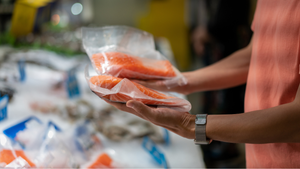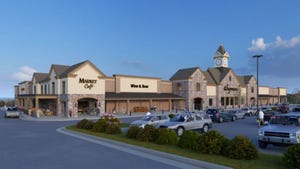How to Meet Retail Foodservice Challenges
Tips to help retailers find workable solutions for prepared foods programs. The addition of foodservice and delivery options to the traditional retail store is a winning strategy, but one that requires good partners and best practices.
June 27, 2019

Not sure foodservice should be an important component of your business plan? Ample inspiration can be found in the strategy of Rochester, N.Y.-based Wegmans Food Markets, which continues to expand its foodservice options with tremendous success.
The regional grocery chain and longtime retail foodservice leader recently partnered with DoorDash to deliver items such as sushi, pizza, wings, subs, salads, soups, ready-to-heat meals, desserts and beverages that are available in its new Meals 2Go app. Wegmans currently offers the service at six stores (one in Northern Virginia and five in its hometown marketing area) and plans to roll out the service to more than 40 stores by year’s end, with even more stores scheduled to follow in 2020. Customers order via the app and can opt for delivery, carryout or curbside pickup.
Wegmans’ foray into meal delivery is just the latest iteration of the foodservice trend heating up the world of grocery retailing. And the company isn’t alone.
“Home delivery and retail meal pickup options have become a greater trend than before for retail stores,” says Todd Bernitt, VP of global services for Robinson Fresh. “Most large retailers have curbside pickup available. Almost always there is a mobile application involved in the consumer pickup equation. A consumer orders through a retailer’s or a third-party app then complete a store pick-up.”
Consumers are eating differently than they did a decade ago. That, in a nutshell, is what’s making foodservice a must for grocery retailers today.
“Home prepared meals continue to decrease,” Bernitt says, citing FMI research. “Traditional foodservice foot traffic at fast-casual [restaurants] continues to decline and is being picked up at other areas, foodservice at retail being one of them.”
The popularity of meal kits is another factor affecting the marketplace. According to Nielsen data, 187 new meal kit items were introduced within in-store retail outlets alone during the 52 weeks ending Dec. 29, 2018.
“Meal kits continue to trend upward,” Bernitt says. “A number of customers buy in both the online and in-store channels, with in-store purchases accounting for 60% of the growth in meal kit sales.”
Tackling the Challenges
As popular as foodservice offerings have become for shoppers hoping to grab a prepared—or partially prepared—meal from their local supermarkets, the trend isn’t without its challenges for the stores they shop. “Adding a foodservice component to traditional retail store offerings requires new packaging, processing and customer experiences as compared to traditional brick-and-mortar practices,” Bernitt says.
The ultimate goal is to create the kind of dining experience customers will want to repeat. But that isn’t an easy task for stores to tackle—especially considering they now have to incorporate state-of-the art technology while developing new procedures for product sourcing and assortment.
“Retail stores have had to determine if they are going to move forward with technology on an application either built on their own platform or made available through a third party,” Bernitt says. “With technology comes a required, instant or near-instant assessment of product availability.”
There’s also the question of how much to handle on-site.
As such, retailers need to determine the level of service provided in-house. “As many restaurants know, pickup or delivery require a number of new logistics items, such as the previously mentioned packaging and processing,” Bernitt says. Issues related to the workforce, plus transportation and storage of these new orders, are also challenges that must be met, he says.
Even offering meal kits, which would seem less problematic, presents its own challenges. “Short shelf lives demand high turn on inventory, and if they don’t have enough consumer demand, there is a lot of shrink,” he says. “In order for this area to survive, either shelf life has to be extended or the retailer has to better predict consumer purchasing behavior in this category.”
Supply Chain Is Key
Freshness is key to any foodservice operation. That’s especially true in the current culinary climate—one increasingly focused on healthy and convenient dining options. “Millennial families and Gen Z consumers want more fresh fruits and vegetables in their lives, faster, with less work involved,” Bernitt says. “The solutions for many consumers are meal kits, precut produce, grab and go or other value-added fresh products.”
The problem? A traditional retailer’s supply chain infrastructure is challenged to adapt fast enough, which means stores must seek new solutions and “leverage heavy capital for infrastructure, from how orders are placed at the store level to how long product can sit on shelves before being purchased by a consumer,” he says.
Bernitt identifies two key challenges and offers possible solutions that he says can help “retailers deliver value-added fresh solutions in retail stores, fast.”
Challenge No. 1: Not enough available space in existing distribution centers for quick-turn perishable orders. That means “in and out the door within 24 hours, like for a meal kit or added value goods,” Bernitt says.
The Solution: Handling or processing goods very quickly. This is essential, especially considering the short shelf life of these perishable items. “Often this means processing in the day, then moving overnight or early in the morning to be received at a retail store during unloading hours,” Bernitt says. “If goods are moved faster than in a traditional retail supply chain, supply doesn’t build up, short shelf-life products can be in stores longer and more room is available in distribution centers. The micro supply chain has to be much closer to consumers.”
Challenge No. 2: The number of purchase orders, deliveries and other logistics that are needed from a retailer all day long. In-store employees must place orders constantly, then consolidate to move products with a very short shelf life. “These people should instead be preparing products,” Bernitt says.
The Solution: A separate, quick-turn distribution center that acts like a main distribution center. “This means having the ability to aggregate all orders and deliver at one time to stores while buying from multiple underlying suppliers,” Bernitt says. “This allows for controlling an order guide with items a retailer needs at prices that are validated. These solutions combined create one order, one invoice, one delivery to receive and much time saved.”
Ultimately, Bernitt says, grocery stores will have to function like micro-commissaries to meet foodservice-at-retail challenges successfully.
“This usually means the need for more warehouses, covering more area, faster. This allows for a much higher variety of SKUs and inventory management,” he says. “Instead of a bulk-purchasing or ingredient-based thought process, it’s a different, shorter, quick-meal solutions [process now].”
About the Author
You May Also Like




